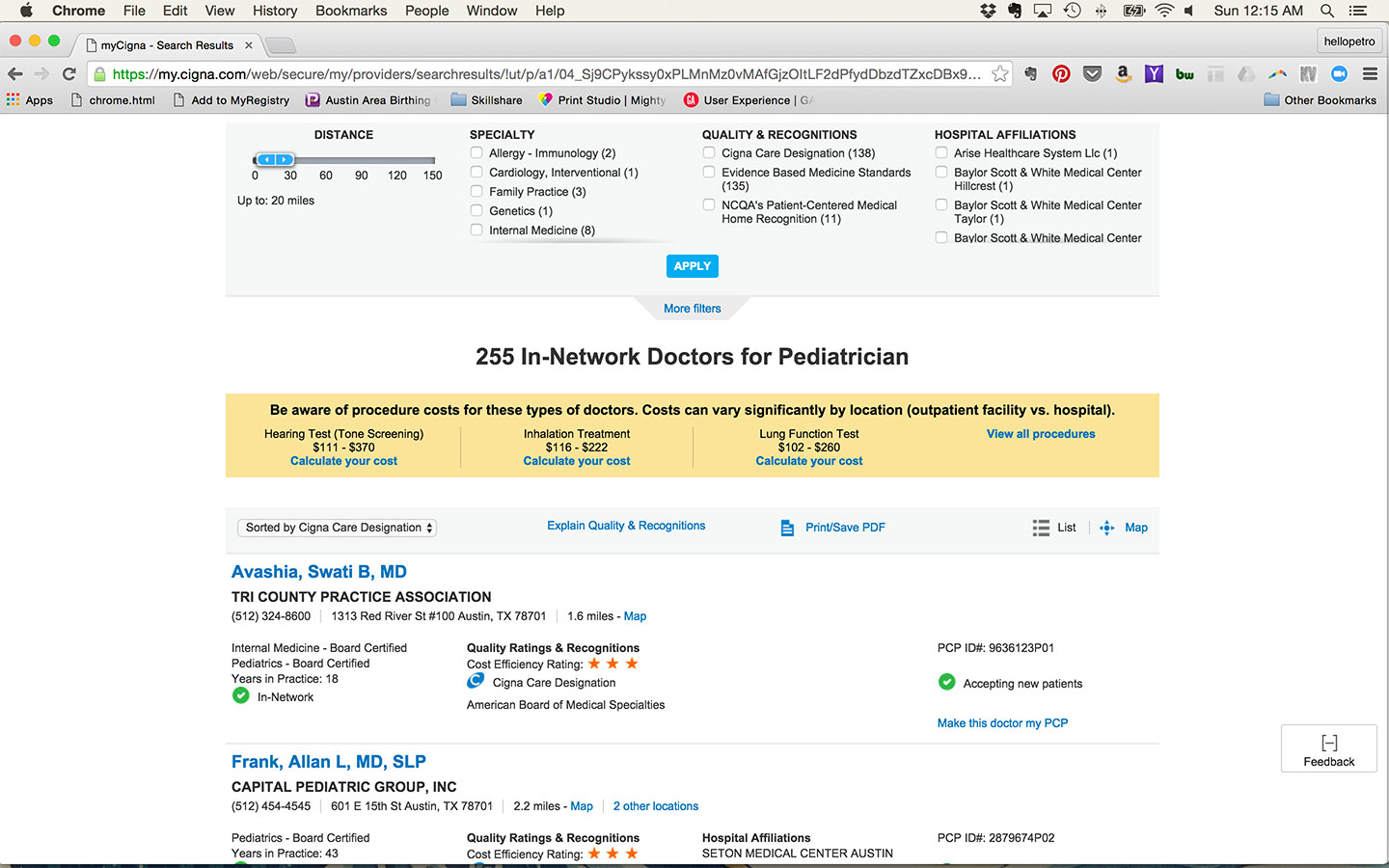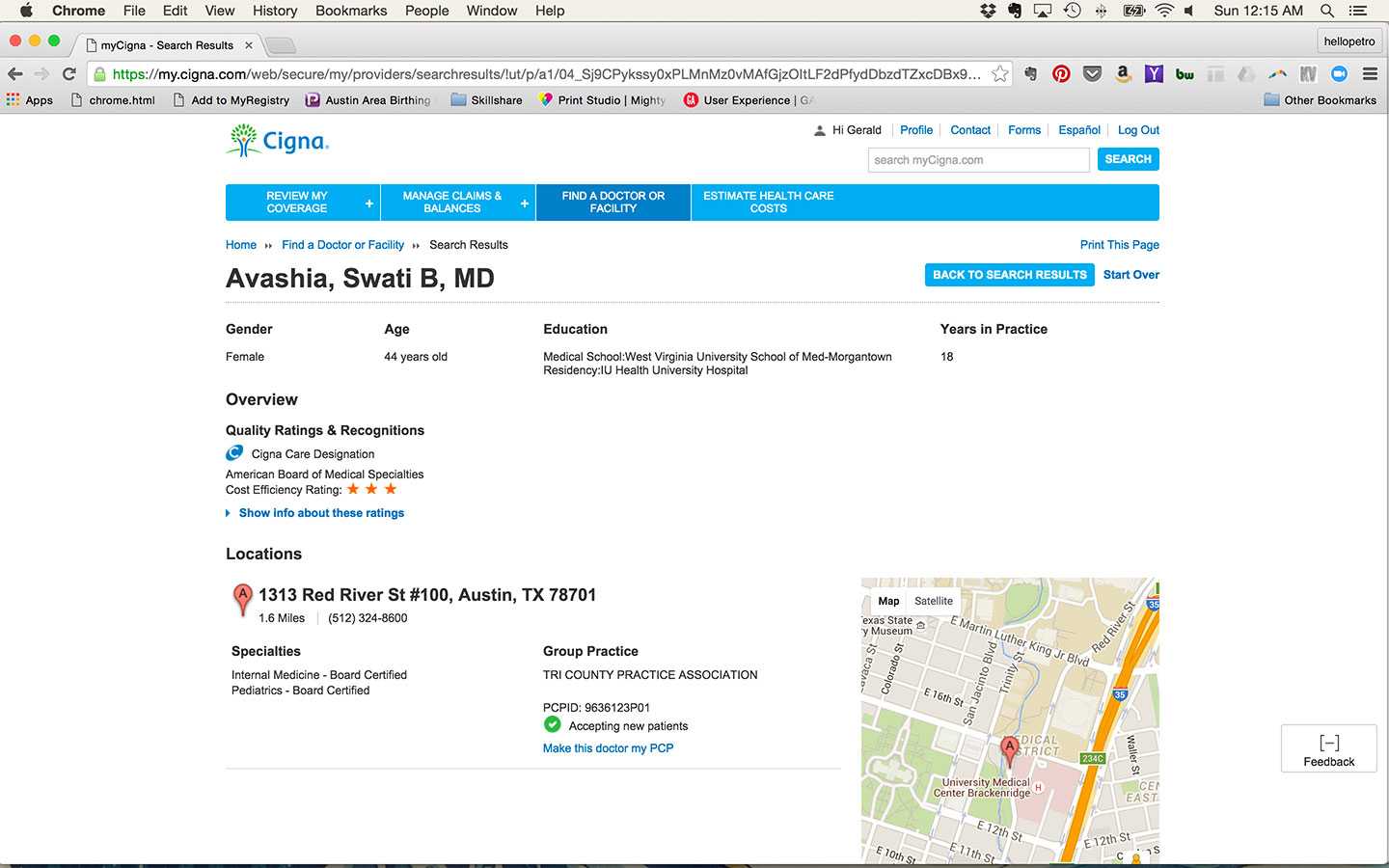FIND A DOCTOR
Initial Field Research
How do people find a doctor?
Choosing a physician is something that everyone has to do at some point, and yet, how does it happen?
What tools do people use and are there opportunities for improvement?
I would like to better understand how individuals go about finding a doctor. In between knowing that they need a (new) doctor and scheduling an appointment, what happens? What's important to them when they are looking for a doctor? What are they interested in knowing about potential physicians?
PROBLEM/CHALLENGE
Today there lots of ways to research any need that you might have. Finding a physician – because of the importance, the potential intimate circumstances, and the prospect of finding a fit for a longterm patient/doctor relationship – can hold some pretty high stakes and possibly take a long time. I am curious to learn how people are finding their physicians and what criteria is important to them.
OBJECTIVE
To uncover potential opportunities for innovation and improvement in current processes or available tools.
APPROACH
I followed a typical UX process for my research project:
- DISCOVERY & RESEARCH – user interviews, defining the problem, competitive analysis
- SYNTHESIZING RESEARCH – affinity mapping, personas, ideating, storyboarding
- DESIGN STRATEGY – user flows, feature prioritization
Discovery & Research
THE RESEARCH PLAN
GOAL – Discover how people go about finding a doctor and what the pain points are
PROCESS – In-person interviews with people who have used a doctor in the past (my target audience)
The interview process:
1. Wrote a research plan – included what I wanted to learn, who my target audience is, what my key areas of inquiry are
2. Wrote a discussion guide
3. Recruited users for interviews
4. Conducted interviews
My key areas of inquiry were:
- Current method of looking for a doctor
- What kind of research is involved?
- What criteria is important to them?
- What kind of results do they get?
- Do they get info by reading reviews?
- Do they write reviews?
Before interviewing, I composed my main questions along with a general script. Questions were developed based on these key areas of inquiry.
USER INTERVIEWS
“There was never one resource that was everything I needed to know. It seems like it was always a collection of broken information.”
“I would want to know if a doctor just wants to throw a prescription at every problem or if they are open to more natural methods. Natural nutrition is important to me.”
“I look at reviews quite a bit. I don’t trust them totally, but I definitely read them and get a feel. They help me navigate.”
“I like a small office, like my primary care doctor’s office where it’s just her and one partner – so the person at the front desk knows me, the nurse knows me, they all know me.”
Additional excerpts from my user interviews:
USER INTERVIEW INSIGHTS: DEFINING THE PROBLEM
What are the goals of the interviewees?
The users I interviewed are drawn to qualities in physicians that often can’t be found online. ...What is their bedside manner like? What is their philosophy/approach? Will they spend time with them or will they rush them through? Will they listen to them and be thorough with their diagnosis? Will the staff be competent and personable?
These users mostly researched physicians online before selecting a doctor or scheduling an appointment, but most admitted that not a lot of information seems to exist online. Many preferred to start with a referral from someone they trust, but if they have no referral, there doesn’t seem to be a good way to analyze the doctor outside of meeting them in person for an appointment.
What's motivating the interviewees?
They only schedule a visit to a new doctor when they need to. So sickness is a motivating factor. Sometimes visiting a specialist is a recommendation by one of their current doctors.
They are motivated to find doctors that they like and feel comfortable with, doctors that they trust, doctors that they share common beliefs with, and doctors who will respect them and give them the time and attention that they believe they deserve as a patient. ...I think these are qualities that anyone looks for in a strong relationship. And I think people naturally desire to build a strong, long lasting relationship with their doctor. No one likes the process of looking for/finding a new doctor.
What's the problem?
Most people prefer to start with referrals when they need a new doctor, but they don’t always start with referrals. And even if they do, many people still need to research/analyze these referrals. Additionally, there is a lack of information online. It is in different places. It is hard to find out anything other than the basics (name, location, education, years of service). It seems like the only way to currently know if you have chosen a doctor who is a good fit is to meet them for an appointment. But does it have to be like this?
The Problem Statement
People in need of a new doctor need a more efficient way to analyze physicians who would be a good fit for them because currently a good online, front end filtering system doesn’t exist.
The Hypothesis
I believe producing a research one-stop shop for people who interact with doctors will provide an in-depth way for people to educate themselves on, review, and recommend physicians.
I will know my hypothesis is true when I see an increase of users/new accounts opened over time.
How Might We...?
- How might we get users to actually write reviews on physicians instead of just using the site as a resource?
- How might we make the process of filling out a form a better experience for the user?
- How might we recreate an experience that’s as good as an in-person referral from someone you know and trust?
- How might we eliminate the need to see a doctor in person to judge whether or not they are a good fit?
- How might we create a deeply engaging environment like LinkedIn or Glassdoor where users spend more time interacting with the site than they originally planned to?
COMPETITIVE ANALYSIS
Assessing competitor products that already exist in the market
Feature Inventory:
Some of the competitor websites that were studied:
Obviously there are lots of features that could be implemented in a software solution, however, it's too soon to decide which kind of features might be relevant since I haven't defined the scope of the work just yet.
Synthesizing Research
AFFINITY MAPPING
I was left with a lot of data after my user interviews and competitive analysis and needed to bring everything together and organize it to make sense of what I had. In order to reveal useful insights, I created an affinity map to break down the ideas and assemble them in a meaningful way.
Below are photos showing how I grouped items from my interviews into trends relating to the problems and desires of the interviewees.
I should comment that synthesizing data is largely a subjective process. It's often messy and can mean reading between the lines and not taking a quote or something observed at face value.
That being said, the key ideas that came out of this:
- #1 idea: users want one source for all the info they need – currently nothing exists
- there is a connection between referrals and trust
- users want info that will allow them to judge doctors
- the insurance side of finding a doctor is frustrating (info on insurance sites, navigating these sites, and finding a doctor that you want to try who is also available and is in-network)
The largest groups in an affinity map identify the biggest trends (aka, what users care about the most). Thus, the affinity map above allowed me to target my ideal user and develop a persona that embodied the goals/most pressing needs shared by most users.
If I had interviewed a lot more people, I'd most likely find more varying goals based on more extreme users, and then I would create multiple personas from the data. However, since this wasn't the case, I created my ideal target user and then created proto personas that would represent more extremes.
THE PERSONAS
IDEATING
I ideated to generate a lot of solutions quickly and to explore a variety of perspectives upfront, before constraining my explorations. I worked on this healthcare research project by myself, however, if I was on a team, ideating/problem solving together would have been a great way to get team member buy-in for solutions.
I started brainstorming "bad ideas" first to just get them out, but I also wanted to see if anything developed that could inspire a great solution. After that, I moved on to brainstorming "good ideas".
STORYBOARDING
The storyboard below provides narration for a user's predicted interaction with this product.
Design Strategy
USER FLOW
FEATURE PRIORITIZATION
Features should always address user needs and/or business goals.
The personas reveal user needs; the storyboard and the user flow reveal how users will interact with the product. Based on these deliverables, the following list outlines possible features for this healthcare software:
- Business Search
- Product/Service Search
- Physician Search
- Specialty Search
- Language Spoken Search
- Location Search
- Create List from Checked Selections
- Map Out Locations
- Filter Search Results
- Education/Articles
- Symptom Checker
- Prices/Estimates
- Reviews on Businesses
- Reviews on Doctors
- Drugs or Product Reviews
- Q&A/Forum Section
- Insurance List of In-Network Providers
- Details of Benefits
Now that I have a list, I assessed the value of each feature to determine which ones would be most worth a time/money investment. Prioritizing the list helps determine which features will be implemented first.
NEXT STEPS
- Placement and Layout Design – Sketch solutions (site map, wireframes) based on my user research; evaluate strengths and weaknesses of options
- Execution – Bring one of the solutions to life as an interactive prototype
- Usability Testing – Explore the functionality and ease of use of the prototype through usability testing; follow with rounds of iterations and more user testing



























